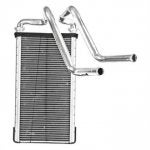Hi All: I'm new to the forum but have been creeping through your posts and knowledge base to help troubleshoot my 10' Patriot. Full of good stuff. I've read many opinions on this topic, but rarely does the poster return to let us know what the issue actually was and/or how remedied.
I'm having a problem with the interior heat on this newly-purchased vehicle. It's a 2010 Patriot Sport (FWD) with 2.5L engine and 137K miles. Heater blows warm (85F) at idle, but only on the driver's side. When I increase engine RPM, heat on both sides increases, but not to the level I would like - roughly (115-120F on driver's side).
I have checked that the blend door actuator works as it should. I drained/changed the coolant (which looked fine), disconnected the heater hoses and blew out the core with compressed air (20PSI). I flushed and back-flushed the core with a garden hose which revealed no gunk or obvious obstructions. Water appeared to flow freely both ways. Blew the water out of the heater core and filled the core with radiator cleaner. Let sit for an hour and did the flushing routine again. Got it all back together again and filled with new coolant - same result as far as output temp.
Aluminum pipe to core is too hot to touch, output is warm at best. I am debating between the core (although it did not appear to be plugged) or a weak water pump. I imagine that mileage alone would dictate water pump replacement anyway and see if it remedies the situation - if not do the core?
Any thoughts or personal experience?
Thanks in advance for your replies.
I'm having a problem with the interior heat on this newly-purchased vehicle. It's a 2010 Patriot Sport (FWD) with 2.5L engine and 137K miles. Heater blows warm (85F) at idle, but only on the driver's side. When I increase engine RPM, heat on both sides increases, but not to the level I would like - roughly (115-120F on driver's side).
I have checked that the blend door actuator works as it should. I drained/changed the coolant (which looked fine), disconnected the heater hoses and blew out the core with compressed air (20PSI). I flushed and back-flushed the core with a garden hose which revealed no gunk or obvious obstructions. Water appeared to flow freely both ways. Blew the water out of the heater core and filled the core with radiator cleaner. Let sit for an hour and did the flushing routine again. Got it all back together again and filled with new coolant - same result as far as output temp.
Aluminum pipe to core is too hot to touch, output is warm at best. I am debating between the core (although it did not appear to be plugged) or a weak water pump. I imagine that mileage alone would dictate water pump replacement anyway and see if it remedies the situation - if not do the core?
Any thoughts or personal experience?
Thanks in advance for your replies.







